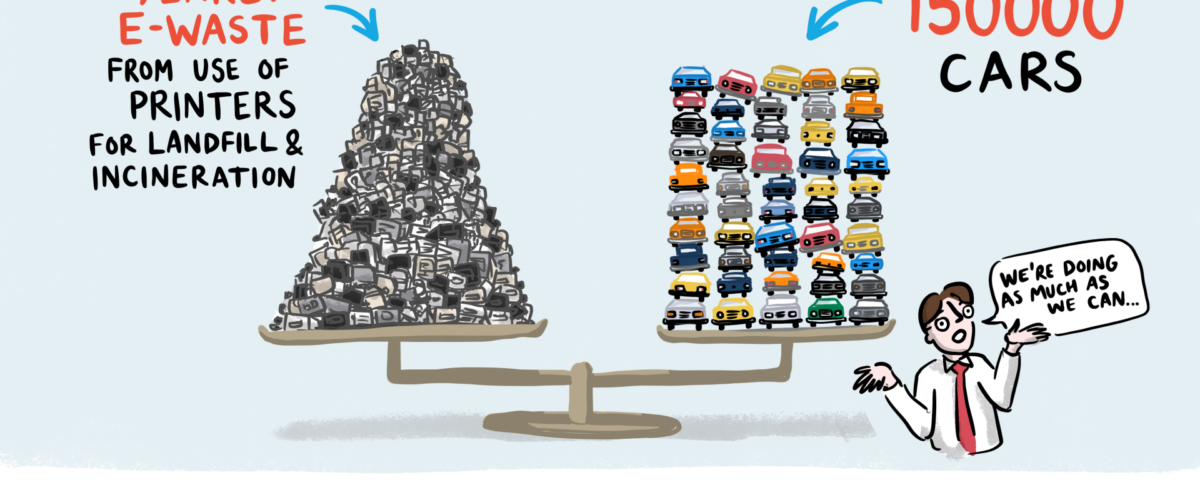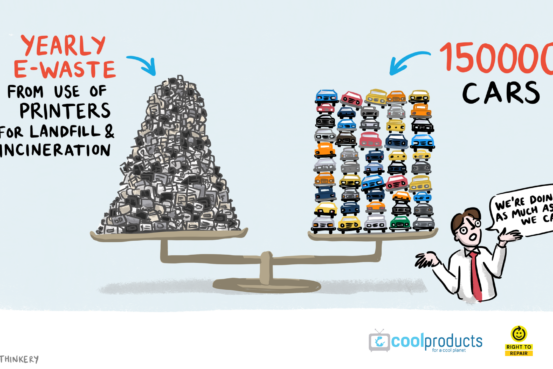Ambitious laws begin with ambitious goals. To lessen the negative environmental impacts of printers and cartridges, laws must be designed with sustainability as a priority. In its new preparatory study on ecodesign possibilities for printers and cartridges, the European Commission has created a solid starting point for what could become impactful ecodesign requirements – but improvements are needed.
The imaging equipment industry, which includes printers and cartridges, is an environmentally impactful sector that generates over 600,000 tonnes of e-waste every year. It needs strong regulations to ban practices that harm the environment and consumers, such as wasteful design and anti-repair practices.
At the end of February 2024, the European Commission’s research body, the Joint Research Centre (JRC), published its preparatory study on printers and cartridges. It is a first step towards binding ecodesign requirements (expected later this year) and we are happy to see the study tackle issues not covered before by EU legislation.
This is a great improvement on the current Voluntary Agreement, which does not cover consumables (such as cartridges), so is not enough to end the early obsolescence of printers or properly regulate the goods they unavoidably use. The new JRC study paves the way for more ambitious requirements with an extended scope to cover consumables This will encourage resource efficiency and help to improve and push for remanufactured consumables – all needed to ensure more sustainably designed printers and cartridges.
However, the JRC study has shortcomings that the Commission should address when drafting the legislative requirements.
Energy labels are still missing
A major flaw of the JRC study is that it dismisses the need for an energy label. Energy labelling is a simple way of communicating to users the environmental impacts of a product, empowering consumers to make sustainable purchase decisions. A label for printers and consumables could be developed with the same principles as for mobile phones and tablets, driving the market towards the most energy and resource-efficient products.
The JRC study observes huge divergences in energy consumption between different types of printers, like laser and inkjet. Without an energy label, such differences will fly under the radar of consumers, EU institutions, and market surveillance authorities. Such sizable divergences must not be ignored.
The lack of an energy label is also a missed opportunity to develop a repair scoring system, which could appear on the label – as it will be the case for smartphones and tablets starting June 2025.
Cartridges must be resource efficient
Cartridges today are not resource efficient. It is therefore very good news that the JRC study recommends including consumables needed for the proper functioning of devices in new ecodesign rules. Only this way can we ensure the most sustainable imaging equipment.
The JRC suggests a minimum page yield of cartridges: 400 pages for ink cartridges and 2,000 pages for toner cartridges. However, it also suggests that the Commission should reconvene with stakeholders to look for thresholds that would be more acceptable to the industry – despite the current suggestion already being on the low side.
Remanufacture, repair, and reuse – and only then recycle
Remanufacturing, repairing, and reusing must be central to new ecodesign requirements for printers – the waste hierarchy could not be clearer on this.
In a positive step, the JRC report digs into the potential of remanufacturing and repair, which should take centre stage. Today, consumers often avoid remanufactured cartridges due to a lack of trust in suppliers and a fear of lower quality. Certifying the quality of cartridges to raise confidence among end-users would help to address this. Regulations should also push harder for cartridges to be remanufactured and reused. Now, they are primarily recycled, with only 25% refilled or remanufactured. We must shift the focus from recyclability to reusability.
Even if consumers do buy remanufactured cartridges, they risk not being able to use them due to ‘part pairing’. Imaging equipment manufacturers, whose primary source of income is often cartridges, may use physical or electronic barriers to prevent third-party cartridges so a printer does not work correctly, or at all. This is typically done through chips contained in the original cartridges and is an anti-repair or reuse practice that must be swiftly banned.
To address part pairing in printers, the JRC study proposes that chips contained in cartridges should be resettable by “registered professional remanufacturers” at a “reasonable and proportional cost”. However, it would be more effective to simply allow users to reset the printer (for free) when a remanufactured cartridge is installed so that everything runs smoothly.
Finally, as should be the case for all products covered by ecodesign measures, all spare parts should be available to everyone. This would facilitate both do-it-yourself and independent repair. Unfortunately, the JRC study sticks to the Commission’s usual approach of distinguishing parts accessible to consumers from those accessible to professional repairers. Before limiting consumer access to certain spare parts, risks associated with replacing them should be appropriately documented to avoid unnecessary barriers.
The final countdown
Despite the missed opportunities outlined above, the general direction is positive. Addressing these issues in the upcoming negotiations for ecodesign rules for imaging equipment and consumables would make it even more so.
This study sends a message to all industries currently regulated through Voluntary Agreements: boost your environmental credentials, or we will do it for you. It is time to make appropriate ecodesign requirements for printers worth the paper they are printed on.



